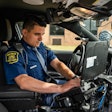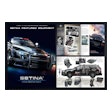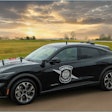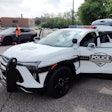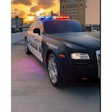Complacency can kill. Whether it's something as mundane as not wearing your seat belt while driving or not wearing body armor during a high-risk entry, failure to take preventive measures can have disastrous results.
The same is true when it comes to securing a law-enforcement vehicle. Although news reports are not full of stories of police patrol vehicles being stolen every day, it happens more often than you might imagine-and the results have deadly potential. In the first four months of this year, more than 30 police departments nationwide experienced a theft of one of their vehicles. Many of these cases simply ended with the car damaged.
However, it's not difficult to imagine a stolen unit being driven by a fleeing felon running down civilians. And if that happens, the affected department is practically guaranteed to be named in a lawsuit. Worse, because a police car grants the driver almost instant access to high-security areas, terrorists would love to get their hands on one.
Their visibility-and the implication that they represent law enforcement-makes police vehicles attractive targets to some criminals. An unmarked SWAT unit might, for example, contain an abundance of weapons and tactical gear that would be a huge score on the streets. Others might simply see the police unit as the nearest means of escape or even a joy ride.
Unfortunately, once the thief is in a speeding police car, the odds shift in his or her favor, making it hard for the good guys to recover the vehicle. "The bad guy has the tactical advantage," says Mark Tremblay, vice president of Tremco Police Products. "While he's in the car, he can monitor the [police] radio or scanner and know if you're setting up a roadblock somewhere, then he can avoid it pretty easily."
Who Steals Police Cars
According to the National Insurance Crime Bureau, there's a car stolen somewhere in the United States once every 27 seconds. Granted, this statistic is for civilian vehicles, but the alarming fact is that law enforcement vehicles are also vulnerable to theft. Such theft is similar in one way to the theft of civilian vehicles in that it's inconvenient, at the very least. But for cops there's an added extra pain to car theft: It's embarrassing for the affected department as well as the individual officer.
So what can an officer or department do to make sure their vehicles remain in their control and egg stays off of their faces?
As with civilian vehicle theft prevention, there are a number of steps that can be taken to prevent unauthorized personnel from driving off in a black-and-white. Many departments feel that locking vehicles and not having "take-home" cars cuts the possibility of theft. True, it does, but there are more than a few instances of locked vehicles being broken into and stolen.
In Maryland, two departments lost one patrol car each on the same day in March. In both cases, the officers were off duty, and the vehicles were locked. Both were recovered within hours. One, an unmarked car, had been hot-wired after the thief pried the passenger door open to gain access.
However, most reports of stolen police vehicles involve suspects who manage to get into a unit that the officer has left unattended, either to take a report or chase someone.
Recently, an Ohio woman was arrested, handcuffed, and placed in the back seat of a patrol car; all four doors were locked. Nonetheless, while the arresting officer and others gathered evidence, she managed to slip her hands from behind her back, underneath her feet, and in front of her. She then crawled through the dividing window and proceeded to drive off. Officers caught her when she crashed the car a short distance later.
A month earlier in Texas, a man walked up to a sheriff's deputy who was sitting in his patrol car and asked for a ride. When the deputy rolled down his window to respond, the suspect managed to enter the vehicle, scuffle with the deputy, and drag him out. The suspect then drove away in the patrol car, though authorities caught him shortly afterward.
Invitations to Crime
The moral of the story is that official cars are indeed theft targets. And they're not only targets; they're soft targets.
One of the reasons it's so easy to steal a police car is that many officers need to keep their units running almost non-stop through a shift, whether they are in the cars or not. This may sound stupid to civilians. But turning the engine off means that the car's battery will drain quickly because of the power demands created by emergency lights and communications systems.
Also, depending on local weather, it can be a necessity to keep the air-conditioner or heater running. And with the proliferation of communication systems, laptops, and other computers in patrol vehicles, turning off the engine often means you've got to power down those instruments, then go through the sometimes inconvenient rebooting procedure-and that's not to mention the need to keep them within a fairly narrow temperature range.[PAGEBREAK]Procedures and Precautions
Consequently, there is certainly a need to secure vehicles from unauthorized use, whether they're attended or not. But what can the individual officer or department do?
There are a number of solutions that agencies are using to combat theft of police vehicles.
The simplest and least expensive option is establishing procedures that require officers to treat the vehicles like the average civilian would his or her personal car. That means the officer is required to lock it on the way out and take the key.
For some agencies, this simple solution is impractical, but others can live with it. "I'm old-fashioned; I turn the cruiser off and lock it," says an Ohio officer.
Of course, it's hard to leave a vehicle running and prevent battery drain when you use this security procedure.
But a Colorado officer offered this solution to the problem. "Since we have take-homes, I just have multiple copies of my car key. I leave one in the ignition when I'm working so I can leave the car running when necessary and not have any problem locking the car. And I always hit the car lock button on the way out."
One Arizona agency offers another variation on this concept by ordering its vehicles keyed alike. The standard procedure is for officers to call when leaving the vehicle, requesting that backup secure it, often by moving it. Obviously, having all units keyed alike makes this possible, even if the first responder leaves the key in the running car and locks the doors.
Technology to the Rescue
High-tech theft prevention devices essentially take one of two approaches to making life hard on car thieves. They stop the theft or they help the authorities track the vehicle once it has been stolen.
Some departments install GPS-linked tracking systems or LoJack devices to keep track of vehicles, but this rarely prevents them from being taken in the first place. These locate the vehicle after a theft. They can also be useful should an officer be unable to communicate his location (due to injury, radio malfunction, lack of time, etc.) and need assistance.
LoJack and similar technologies are great, but they fail to address the potential for an unauthorized person getting into the vehicle and driving it away, especially when the engine is left running with the doors unlocked. Stopping this sort of problem requires a bit more sophisticated solution, and fortunately, there are several available.
To prevent theft during those times when the unit is parked and not in use, many agencies have adopted battery or fuel cut-off systems. Not only are these systems easy to install, but they are actually ideal for modern patrol cars. The on/off switch is easy to "hide" among the many switches so prevalent in today's patrol vehicles.
But what about a vehicle that's unattended and running? One solution is a technology that's also a fairly simple job for any professional mechanic: the brake light kill switch
"Our city garage installed brake light kill switches in our city vehicles," says an Alabama officer. "They work great and an added bonus is that with the brake lights cut off, the car will not come out of "Park," even when running. We've started using this as an impromptu anti-theft device so that we can leave the AC running while on a call and still have a car to come back to."
Of course, brake light kill switches only work on later-model vehicles that require the driver to step on the brake before the automatic transmission can be shifted out of Park.
Another device that protects the vehicle from unauthorized use even when the engine is running is the Secure-Idle. In use, an officer need only press a button, place the transmission in "Park," turn the key to what normally would be the "Off" position, then remove the key. The engine keeps running and all of the vehicle's accessories will remain on, yet any unauthorized attempt to step on the brake or move the shift lever out of Park cuts all electrical power, rendering the vehicle immobile. It can also be set up to trigger an optional alarm.
Deactivating the Secure-Idle system requires that the key be put back into the ignition and turned to the "On" position. It is available for practically any vehicle since the company offers it for the civilian market and can custom build systems. Secure-Idle does stipulate, however, that its technicians must do the install, especially in the custom systems. The cost ranges from $109 to $129 per vehicle.
Using the Secure-Idle system consumes minimal time and ensures the officer takes the key out, reducing the likelihood of locking himself out of the vehicle.
Tremco Police Products produces a Police Package Anti-theft System that works in a similar manner to the Secure-Idle. Available for practically any police service vehicle, it plugs into the standard electrical wiring harness and then requires the installation of a few switches.
Once installed, the Tremco system activates whenever the transmission is placed into Park; no other switch needs to be pressed. Whether the engine is running or not, the shift lever cannot be shifted out of Park unless a hidden foot switch is pressed, sounding a small buzzer that indicates deactivation of the anti-theft system.
For those times when civilians might need to operate the vehicle (the mechanic at a local garage, a car wash attendant, etc.), the Tremco system features a hidden bypass switch that turns the entire system off so the car operates normally. All you have to do is turn off the system when you turn the car over to a citizen, and turn it on again when you take the car back.
Tremco claims its system usually takes 15 minutes or less to install, and it can easily be done by anyone with normal tools and some mechanical aptitude. The cost is $89 per vehicle.
When you consider the potential liability-not to mention the embarrassment-of stolen law-enforcement vehicles, installing an anti-theft device of some sort becomes a no-brainer.
Of course, there is one type of patrol vehicle that seems to be immune to theft: the K-9 unit. For some reason, most people think twice about trying to heist a car that has a built-in set of teeth accompanied by vicious barking. But unless you're one of the small percentage of officers who turn out each day with a dog, you need to take precautions and consider technology that can prevent your car from leaving without you.
Securing Motorcycles
Motor officers are also vulnerable to the problem of patrol-vehicle theft, but it's much less common. This may be due to the dynamics of the motor officer's duties and the vehicle itself.
After all, a motorcycle's inherent attitude is lying on its side; a two-wheeled vehicle cannot stand upright on its own. That means a motor officer must put the kickstand down unless he's under fire and opts to lay it down to use as cover.
So the motor officer already has one step that must be performed fairly deliberately when it comes to parking the bike. So he shouldn't forget to take his key with him.
Also, he shouldn't leave the engine running. There are no air conditioners or heaters to keep running on a motorcycle. And the air-cooled powerplants on the majority of bikes in police service are not designed to idle while motionless. What that means is that leaving the engine running on your motorcycle will accomplish nothing, and it will make the engine overheat.
For the motor officer, there is no anti-theft system that works quite like the ones available for patrol cruisers or other vehicles with automatic transmissions. One reason is the fact that no motorcycles in current police service utilize automatic transmissions; they're all manual-shift units. About the only bikes with automatic-style transmissions tend to be scooters.
Many of the current anti-theft systems targeted at the civilian motorcycle market are locking devices that, while effective, also tend to be somewhat cumbersome and time-consuming to employ. There's little chance the average motor officer will take the time to put one of these on while making a routine traffic stop, and there's no chance of him or her locking the bike during an emergency response.
Probably the best the officer can plan for is an alarm system. Most will trigger a loud horn or buzzer if the bike is moved. Some incorporate even more features. The $219 Airitronix CYL-300ex sounds its alarm if anyone approaches a predetermined perimeter around it. It also offers a paging option to notify you when the alarm is triggered.
The $149.95 Armed Guard Pager system has many of the same features as the Airitronix alarm. Installation of either requires some mechanical aptitude and a few tools.
But even if your motorcycle isn't protected by a lock or alarm, consider this: We've been unable to verify a single instance of a police motorcycle being ridden away by joy riders. And that's more than we can say about police horses-but that's another story.
For More Information
Airitronix
www.airitronix.com
Armed Guard
www.armedguard.com
Secure-Idle
www.westfrankfort.com/fwhs/secure.htm
Tremco Police Products
www.tremcopoliceproducts.com
Mark Kariya is a freelance writer and photographer whose duties over the past 24 years have included vehicle evaluation. To date, the only vehicle theft he's suffered has been a bicycle.









